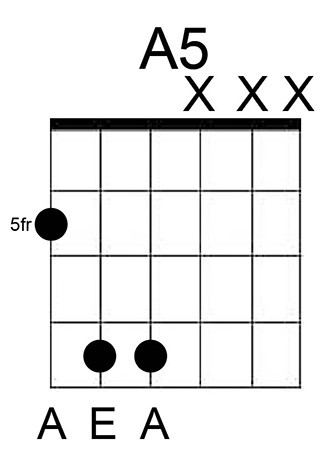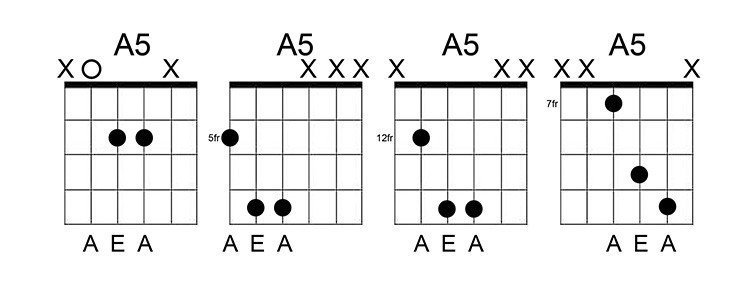The A5 chord is a staple for guitarists across genres, celebrated for its raw power and versatility. This guide will equip you with everything you need to know about the A5 chord, from beginner-friendly versions to advanced techniques, ensuring you can confidently incorporate this essential chord into your playing.
Unlocking the A5 Chord: Beginner-Friendly Versions
The A5 chord’s popularity stems from its simplicity and effectiveness. It’s a fundamental chord in any guitarist’s toolkit, adaptable to countless musical contexts. Let’s start with the most common entry point for beginner guitarists:
(If you’re unfamiliar with chord diagrams, please refer to a guide on reading guitar chord boxes for a quick understanding.)
[Image of the beginner version of A5 chord diagram]
 Beginner friendly A5 guitar chord diagram using index and middle fingers on D and G strings at the second fret
Beginner friendly A5 guitar chord diagram using index and middle fingers on D and G strings at the second fret
There are two primary ways to play this beginner A5 chord:
- Two-Finger Method: Place your index finger on the D string, 2nd fret, and your middle finger on the G string, 2nd fret.
- Barre Method (Partial): Barre your index finger across both the D and G strings at the 2nd fret.
For both methods, strum from the open A string down to the G string.
Technique Tip: Focus on strumming only the desired strings (A, D, G) and avoid accidentally hitting the B and high E strings for a cleaner A5 chord sound.
While the two-finger version is often easier for beginners, practicing both techniques will enhance your finger strength and dexterity. Remember, the correct notes are what define the chord, regardless of your fingering method.
Understanding the A5 Chord: Notes and Theory
What makes up an A5 chord? It’s surprisingly simple: just two notes – A and E.
In music theory, these notes correspond to the root (1st) and the perfect fifth (5th) degrees of the A major scale (and many other scales in the key of A). These scale degrees are fundamental and rarely change, making the A5 a solid foundational chord, especially for those new to guitar.
Unlike major or minor chords, the A5 chord’s two-note structure means it is neither major nor minor. This unique characteristic provides the A5 with a tonally ambiguous quality, often described as “darker” or more “open” compared to its major and minor counterparts. This ambiguity is precisely what makes it so versatile and adaptable across different musical styles. Think of “5 chords” as stripped-down, potent versions of full major and minor chords.
Ear Training Exercise: Play an A Major chord, then an A Minor chord, and finally the A5 chord. Pay close attention to the tonal differences between each.
Actively listening for these nuances will train your ear to recognize different chord types and improve your musical perception over time. This skill requires focused listening, not passive absorption. Close your eyes and concentrate on the subtle sonic textures of each chord.
[Image comparing A Major, A Minor, and A5 chords, visually highlighting the simplicity of A5]
 Comparison image showing A Major, A minor and A5 guitar chords to highlight the difference and simplicity of the A5
Comparison image showing A Major, A minor and A5 guitar chords to highlight the difference and simplicity of the A5
Power Up Your Playing: The A5 Power Chord
“5 chords” are commonly known as “power chords,” particularly in rock and heavier genres. Let’s explore the quintessential power chord version of the A5.
Practice switching between the A5 and E5 power chords using the diagram below:
Technique Tip: Experiment with different strumming patterns. Try both up and down strums, and then focus solely on downstrokes. The key is to isolate your strumming to the correct strings for a clear and powerful sound.
[Image of A5 power chord shape on the E string at the 5th fret]
 A5 guitar power chord diagram on the low E string at the 5th fret
A5 guitar power chord diagram on the low E string at the 5th fret
Power Chords and Fifths: Clearing Up Terminology
A quick clarification on terminology: technically, any “5-style” chord like A5 is a power chord, regardless of how it’s played. However, in guitar parlance, “power chord” often specifically refers to the three-string version, like the one we just covered.
Pro Tip: Many guitarists use “fifths” interchangeably with “power chords” because they are all named “Something 5,” such as A5, D5, and E5.
Power chords are favored in rock music for their full, “beefier” sound. However, their versatility extends far beyond rock. They are effective in funk, pop, blues, and many other genres.
Let’s examine the most popular A5 power chord voicing, played at the 5th fret on the low E string:
[Image of A5 power chord diagram at the 5th fret, low E string]
 A5 power chord diagram at the 5th fret on the low E string
A5 power chord diagram at the 5th fret on the low E string
Now, grab your guitar pick, turn up your amplifier (if you have one), add a touch of gain or overdrive, and powerfully strum those three strings (E, A, D) of the A5 power chord.
Feel the energy?
Next, try arpeggiating the chord – picking each of the three strings individually, letting them ring out in succession.
Hear the contrast? This demonstrates the A5’s dynamic range. It can be a heavy, driving chord or a lighter, more melodic sound. The choice is yours, depending on the musical context.
To further explore arpeggios, check out dedicated lessons on guitar arpeggios.
Let’s discover more positions for playing the A5 chord.
[Image illustrating the versatility of the A5 chord and its different sonic possibilities]
 Montage image illustrating different sonic textures and musical genres suitable for A5 chord
Montage image illustrating different sonic textures and musical genres suitable for A5 chord
Expanding Your A5 Chord Vocabulary: Three More Positions
As we’ve seen, the A5 chord is readily accessible in various positions across the guitar fretboard. Exploring these positions enhances your fretboard awareness and expands your chord vocabulary.
Let’s examine a higher-pitched A5 position at the 12th and 14th frets:
This higher fretboard A5 offers a brighter, less heavy tonality compared to the lower position power chords. While still usable in rock, this voicing shines on acoustic guitar or with clean electric guitar tones, perhaps with some reverb and delay effects.
Challenge Yourself: Experiment with each A5 variation we’ve discussed and discern the subtle sonic differences. Once you’re comfortable with A5, try applying the same “5-style” chord concept to other roots, like G5. For instance, G5 would use the same shape, shifted down to the 10th fret on the A string.
[Image of a higher position A5 chord diagram, around the 12th fret]
 Higher position A5 guitar chord diagram around the 12th fret
Higher position A5 guitar chord diagram around the 12th fret
Remember, even though these are different positions of the same A5 chord, they offer distinct tonal colors due to their placement on the fretboard and string sets.
Learning multiple voicings of the same chord is a valuable skill. However, mastering a few core versions thoroughly is perfectly acceptable, especially when starting out.
You can maintain the same two-finger hand shape (index and ring finger, two frets apart, one string apart) for many of these A5 variations. The beauty of the “5-shape” is its movability!
You can also extend the power chord shape by adding your pinky finger to play an octave higher root note (A) on top, creating a fuller voicing. This is optional but beneficial practice.
Finally, consider a bonus A5 voicing on the D string at the 7th fret. The same movable shape applies here; just shift your pinky finger up one fret if you wish to add the octave.
[Image of a chord chart showing various A5 chord positions, including the D string 7th fret version]
 Comprehensive A5 guitar chord chart showing various positions including the D string 7th fret version
Comprehensive A5 guitar chord chart showing various positions including the D string 7th fret version
The Power of Simplicity: Why the A5 Chord Works
The A5 chord’s effectiveness lies in its “reduced” sonic footprint. It’s not cluttered with numerous notes, making it both easy to play and highly adaptable in musical arrangements.
Its two-note structure makes it accessible for beginners and a versatile tool for experienced players. The A5 can be a driving force in punk rock with heavy distortion, creating a massive, aggressive sound. Conversely, its open sound also allows it to function beautifully in gentler contexts, providing a thick harmonic foundation without overpowering a vocalist.
Skill Tip: The A5 chord is excellent practice for beginner guitarists developing finger strength and fretboard pressure. It delivers a full sound without requiring excessive finger stretches. It’s equally valuable for experienced guitarists seeking a less harmonically complex chord voicing for different musical textures.
(Continue reading for more advanced A5 chord techniques and musical applications on further pages, if applicable in a multi-page format.)
